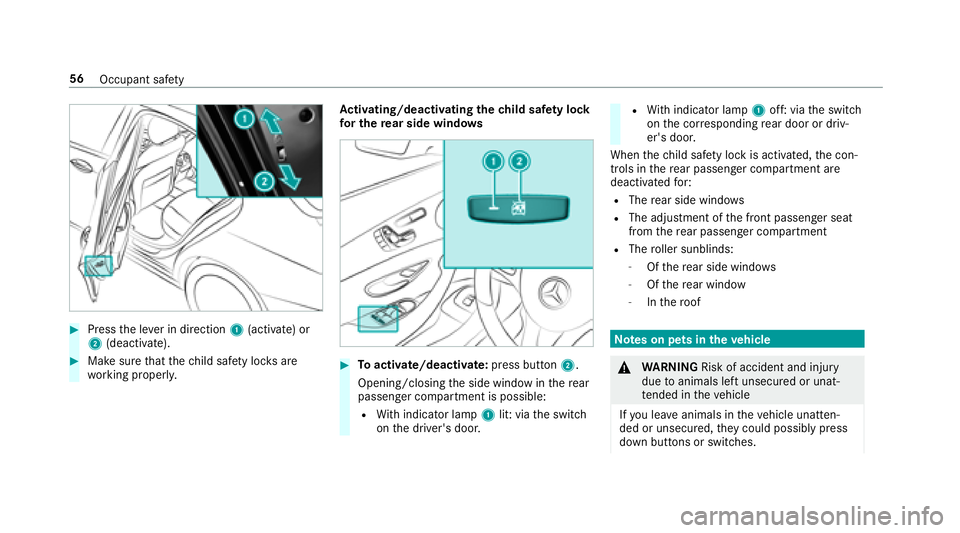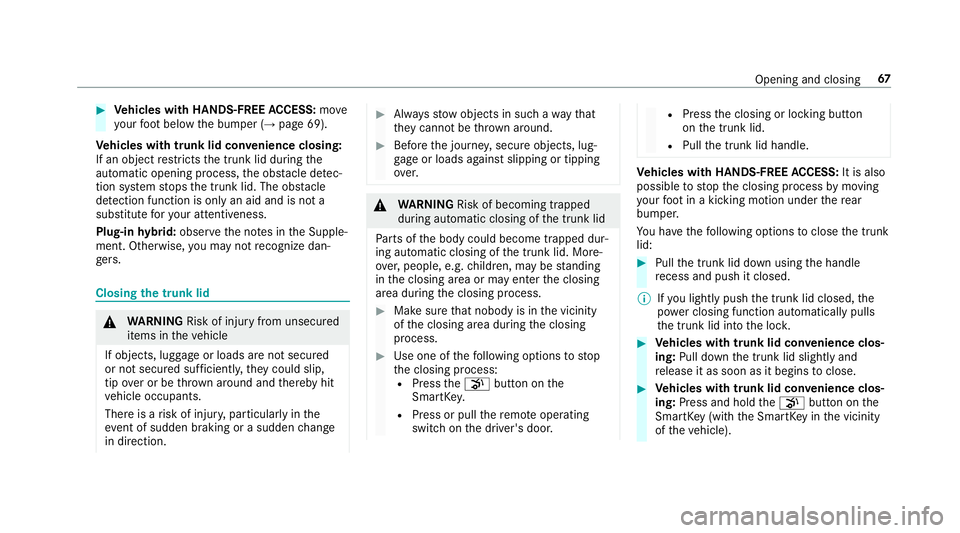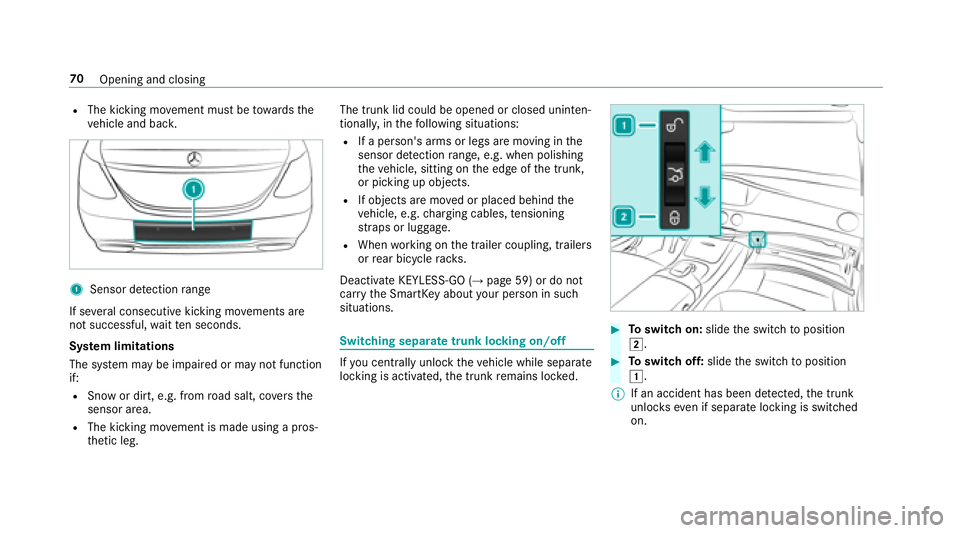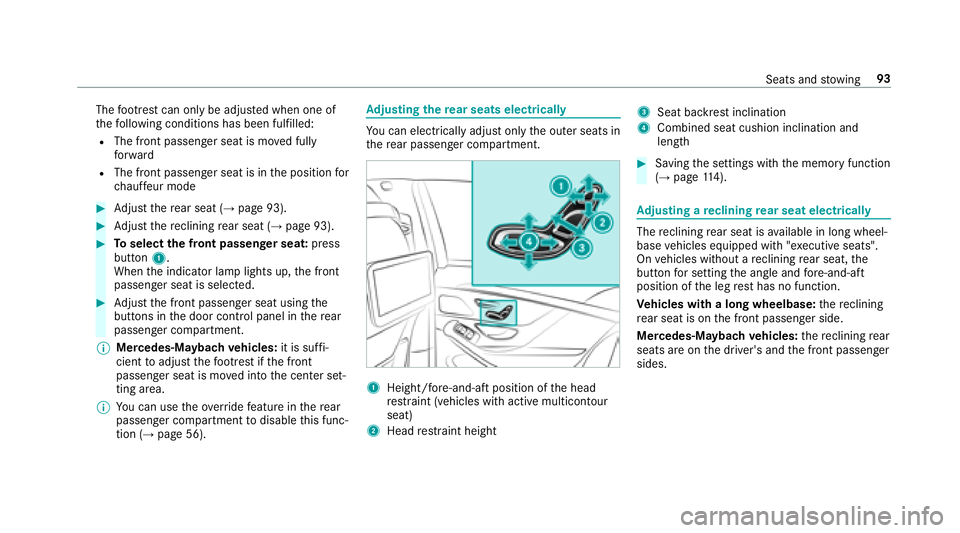2018 MERCEDES-BENZ S-CLASS SEDAN ECU
[x] Cancel search: ECUPage 57 of 562

Child safety loc ks
Activating/deactivating the child saf ety lock
fo r the rear doors
&
WARNING Risk of accident and injury
due tochildren left unatte nded inthe
ve hicle
If yo u lea vechildren unaccompanied in the
ve hicle, they may be able toset theve hicle in
motion, forex ample by:
RRe leasing the parking brake.
RShifting the transmission out of park
position j.
RStarting the engine.
In addition, they may operate vehicle equip‐
ment.
#Ne ver lea vechildren and animals unat‐
te nded in theve hicle.
#When leaving theve hicle, alw aysta ke
th e SmartK eywith you and lock the
ve hicle.
&
WARNING Risk offata l injury due to
ex posure toextreme heat or cold in the
ve hicle
If people – particularly children – are
ex posed toextreme heat or cold over an
ex tended pe riod of time, there is a risk of
injury or evenfa ta l injur y.
#Never lea veanyone – pa rticularly chil‐
dren – unatte nded intheve hicle.
&
WARNING Thereis arisk of accident
and injury if you lea vechildren unatte n‐
ded in theve hicle
If ch ildren are tra veling in theve hicle, they
could:
ROpen doo rs,th ereby endangering other
persons or road users.
RGet out of theve hicle and be hit by
oncoming traf fic.
ROpe rate ve hicle equipment and become
trapped, forex ample.
#Alw ays activate thech ild saf etyloc ks
av ailable if children are tra veling in the
ve hicle.
#Ne ver lea vechildren unatte nded inthe
ve hicle.
#When leaving theve hicle, alw aysta ke
th e SmartK eywith you and lock the
ve hicle.
Child saf etyloc ksare available forth ere ar doors
and forth ere ar side wind ows.
The child saf etyloc kon there ar doors secures
each door separatel y.The doors can no longer
be opened from the inside.
Occupant saf ety 55
Page 58 of 562

#Pressthe le ver in direction 1(activate) or
2 (deactivate).
#Make sure that thech ild saf etyloc ksare
wo rking properly. Ac
tivating/deactivating the child saf ety lock
fo r the rear side windo ws#Toactivate/deacti vate:press button 2.
Opening/closing the side window in there ar
passenger compartment is possible:
RWi th indicator lamp 1lit: via the switch
on the driver's door.
RWi th indicator lamp 1off: via the switch
on the cor responding rear door or driv‐
er's door.
When thech ild saf etyloc kis activated, the con‐
trols in there ar passenger compartment are
deactivated for:
RThe rear side wind ows
RThe adjustment of the front passenger seat
from there ar passenger compartment
RThe roller sunblinds:
-Of there ar side wind ows
-Ofthere ar wind ow
-Inthero of
Note s on pets in theve hicle
&
WARNING Risk of accident and injury
due toanimals left unsecured or unat‐
te nded in theve hicle
If yo u lea veanimals in theve hicle unatten‐
ded or unsecured, they could possibly press
down buttons or switches.
56 Occupant saf ety
Page 59 of 562

Thereby an animal may:
Ractivatevehicle equipment and become
trapped, forex ample
Rswitch systems on or off and endanger
ot her road users
Uns ecured animals may be throw n around in
th eve hicle in theeve nt of an accident or
sudden steering and braking maneuver and
injure vehicle occupants in the process.
#Ne ver lea veanimals in theve hicle unat‐
te nded.
#Alw ays cor rectly secure animals while
driving, forex ample using a suitable
animal car rier.
Occupant saf ety 57
Page 69 of 562

#Vehicles with HANDS-FREE ACCESS: move
yo ur foot below the bumper (→page 69).
Ve hicles with trunk lid co nvenience closing:
If an object restricts the trunk lid during the
automatic opening process, the obs tacle de tec‐
tion sy stem stops the trunk lid. The obs tacle
de tection function is only an aid and is not a
substitute foryo ur attentiveness.
Plug-in hybrid: obser vethe no tes in the Supple‐
ment. Otherwise, you may not recognize dan‐
ge rs.
Closing the trunk lid
&
WARNING Risk of injury from unsecured
items in theve hicle
If objects, luggage or loads are not secured
or not secured suf ficientl y,they could slip,
tip ove r or be throw n around and thereby hit
ve hicle occupants.
There is a risk of injur y,particularly in the
ev ent of sudden braking or a sudden change
in direction.
#Alw aysstow objects in such a wayth at
th ey cannot be thro wn around.
#Before the journe y,secure objects, lug‐
ga ge or loads against slipping or tipping
ove r.
&
WARNING Risk of becoming trapped
duri ng au tomatic closing of the trunk lid
Pa rts of the body could become trapped dur‐
ing automatic closing of the trunk lid. More‐
ove r,people, e.g. children, may be standing
in the closing area or may enter the closing
area during the closing process.
#Make sure that nobody is in the vicinity
of the closing area during the closing
process.
#Use one of thefo llowing options tostop
th e closing process:
RPress thep button on the
SmartK ey.
RPress or pull there mo teoperating
switch on the driver's door.
RPress the closing or locking button
on the trunk lid.
RPull the trunk lid handle.
Ve hicles with HANDS-FREE ACCESS: It is also
possible tostop the closing process bymoving
yo ur foot in a kicking motion under there ar
bumper.
Yo u ha vethefo llowing options toclose the trunk
lid:
#Pull the trunk lid down using the handle
re cess and push it closed.
% Ifyo u lightly pushthe trunk lid closed, the
po we r closing function au tomatical lypulls
th e trunk lid into the loc k.
#Vehicles with trunk lid co nvenience clos‐
ing: Pull down the trunk lid slightly and
re lease it as soon as it begins toclose.
#Ve hicles with trunk lid co nvenience clos‐
ing: Press and hold thep button on the
SmartK ey(with the SmartK eyinthe vicinity
of theve hicle).
Opening and closing 67
Page 72 of 562

RThe kicking movement must be towa rdsth e
ve hicle and bac k.
1Sensor detection range
If se veral consecutive kicking mo vements are
not successful, waitte n seconds.
Sy stem limitations
The sy stem may be impaired or may not function
if:
RSnow or dirt, e.g. from road salt, co vers the
sensor area.
RThe kicking mo vement is made using a pros‐
th etic leg. The trunk lid could be opened or closed unin
ten‐
tional ly, in thefo llowing situations:
RIf a person's arms or legs are moving in the
sensor de tection range, e.g. when polishing
th eve hicle, sitting on the edge of the trunk,
or picking up objects.
RIf objects are mo ved or placed behind the
ve hicle, e.g. charging cables, tensioning
st ra ps or luggage.
RWhen working on the trailer coupling, trailers
or rear bicycle rack s.
Deactivate KEYLESS-GO (
→page 59) or do not
car rythe SmartK eyabout your person insuch
situations.
Switch ing separate trunk locking on/off
Ifyo u centrally unlo cktheve hicle while separate
locking is activated, the trunk remains loc ked.
#To switch on: slidethe switch toposition
2.
#To switch off: slidethe switch toposition
1.
% If an accident has been de tected, the trunk
unloc kseve n if separate lo cking is switched
on.
70 Opening and closing
Page 95 of 562

Thefoot re st can only be adjus ted when one of
th efo llowing conditions has been fulfilled:
RThe front passenge r seat is moved fully
fo rw ard
RThe front passenger seat is in the position for
ch auf feur mode
#Ad just there ar seat (→page 93).
#Ad just there clining rear seat (→page 93).
#To select the front passenger seat: press
button 1.
When the indicator lamp lights up, the front
passenger seat is selected.
#Ad just the front passenger seat using the
buttons in the door control panel in there ar
passenger compartment.
% Mercedes-M aybach vehicles: it is suffi‐
cient toadjust thefo ot re st ifth e front
passenger seat is mo ved into the center set‐
ting area.
% You can use theove rride feature in there ar
passenger compartment todisable this func‐
tion (
→page 56).
Ad justing the rear seats electrical ly
You can electrically adjust only the outer seats in
th ere ar passenger compartment.
1Height/fore-and-aft position of the head
re stra int (vehicles with active multicontour
seat)
2Head restra int height
3Seat backrest inclination
4Combined seat cushion inclination and
length
#Saving the settings with the memory function
(→page 114).
Ad justing a reclining rear seat electrical ly
Thereclining rear seat is available in long wheel‐
base vehicles equipped with "e xecuti veseats".
On vehicles without a reclining rear seat, the
button for setting the angle and fore -and-aft
position of the leg rest has no function.
Ve hicles with a long wheelbase: there clining
re ar seat is on the front passenger side.
Mercedes-Maybach vehicles: there clining rear
seats are on the driver's and the front passenger
sides.
Seats and stowing 93
Page 121 of 562

&WARNING Risk of injury from unsecured
items in theve hicle
If objects, luggage or loads are not secured
or not secured suf ficientl y,they could slip,
tip ove r or be throw n around and thereby hit
ve hicle occupants.
There is a risk of injur y,particularly in the
ev ent of sudden braking or a sudden change
in direction.
#Alw aysstow objects in such a wayth at
th ey cannot be thro wn around.
#Before the journe y,secure objects, lug‐
ga ge or loads against slipping or tipping
ove r.
&
WARNING Risk of injury from incorrectly
stowe d objects
If objects in theve hicle interior are stowed
incor rectly, they can slide or be throw n
around and hit vehicle occupants. In addi‐
tion, cup holders, open stowage spaces and
mobile phone brac kets cann otalw aysre tain
all objects they contain.
There is arisk of injur y,particularly in the
ev ent of sudden braking or a sudden change
in direction.
#Alw aysstow objects so that they can‐
not be throw n around in such situa‐
tions.
#Alw ays make sure that objects do not
pr otru de from stowage spaces, luggage
nets or stowage nets.
#Close the loc kable stow age spaces
before starting a journe y.
#Alwaysstow and secure heavy, hard,
pointe d, sharp-edged, fragile or bulky
objects in the trunk.
&
WARNING Risk of burn s fromtailpipes
and tailpipe trim
The tailpipe and tailpipe trim can become
ve ry hot. If you come into contact withth ese
parts of theve hicle, you could burn yourself.
#Alw ays be particular lycareful around
th eta ilpipe and theta ilpipe trim.
#Allow theve hicle parts tocool down
before youto uch them.
The handling characteristics of your vehicle are
dependent on the distribution of the load within
th eve hicle. You should bear thefo llowing in
mind when loading theve hicle:
RNe verex ceed the maximum permissible
gross mass or the permissible axle loads for
th eve hicle (including occupants). The values
are specified on theve hicle identification
plate on theve hicle's B-pillar.
RThe load must not pr otru de abo vethe upper
edge of the seat backrests.
RAlw ays place the load behind unoccupied
seats if possible.
RSecure the load using the parcel net hooks.
Distribute the load on the parcel net hooks
eve nly.
Seats and stowing 11
9
Page 122 of 562

Stow age spaces in theve hicle interior
Overview of the front stowage compa rt‐
ments
& WARNING Risk of injury from incorrectly
stowe d objects
If objects in theve hicle interior are stowed
incor rectly, they can slide or be throw n
around and hit vehicle occupants. In addi‐
tion, cup holders, open stowage spaces and
mobile phone brac kets cann otalw aysre tain
all objects they contain.
There is arisk of injur y,particularly in the
ev ent of sudden braking or a sudden change
in direction.
#Alw aysstow objects so that they can‐
not be throw n around in such situa‐
tions.
#Alw ays make sure that objects do not
pr otru de from stowage spaces, luggage
nets or stowage nets.
#Close the loc kable stow age spaces
before starting a journe y.
#Alwaysstow and secure heavy, hard,
pointe d, sharp-edged, fragile or bulky
objects in the trunk.
Obser vethe no tes on loading theve hicle.
1Stow age compartment in the doors
2St ow age/telephone compartment in the
armrest with multimedia and USB ports as
we ll as stow age space, e.g. for an MP3
pla yer
3Stow age compartment in the front center
console
4Glo vebox Locking or unlocking
thegl ove box
#Turn the mechanical key a quarter turn clock‐
wise 2(to lock) or counter-clockwise 1(to
unlock).
12 0
Seats and stowing